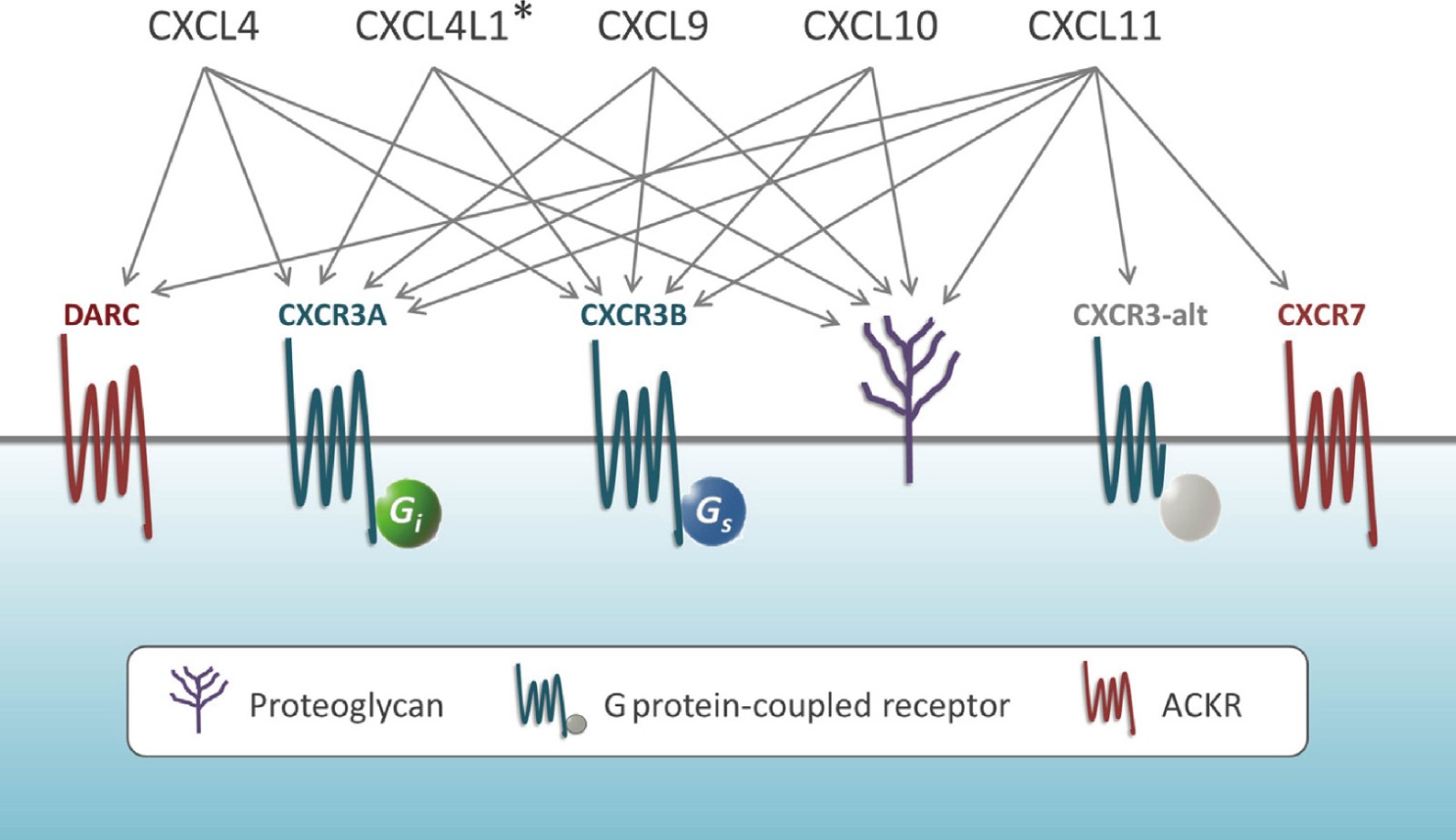
Our promise to you:
Guaranteed product quality, expert customer support.
 24x7 CUSTOMER SERVICE
24x7 CUSTOMER SERVICE
 CONTACT US TO ORDER
CONTACT US TO ORDER
CXCR3 Gene Editing 
CXCR3 is a G-protein coupled receptor that binds to ELR-negative CXC chemokines which have been found to impact vascular development, immune responses, and wound repair. CXC chemokines including CXCL9, CXCL10, CXCL11, CXCL4 and its non-allelic variant CXCL4L1 are the members of ELR-negative CXC chemokine subfamily and all bind to the CXCR3 chemokine receptors. However, the ligands bind to the CXCR3 isoforms with different affinities. So far, three variants of CXCR3 are identified (CXCR3-A, CXCR3-B and CXCR3-alt) with the two primary ones, CXCR3-A and CXCR3-B, considered to induce opposite physiological functions. Recently, CXCR3 has been examined in the context of cancer and increased expression in many human tumors has been correlated with poor prognosis in melanoma, breast, colon and renal cancer patients.
 Figure 1. Receptor binding by the human CXCR3 ligands. (Van Raemdonck K, et al., 2015)
Figure 1. Receptor binding by the human CXCR3 ligands. (Van Raemdonck K, et al., 2015)
CXCR3 and Tumor Cell Invasion and Angiogenesis
The vasculature has been proven to express CXCR3 and to respond to CXCR3 ligands. A level of complexity is added by the presence of three CXCR3 splice variants, which seem to be differentially expressed in the vasculature. The distribution of CXCR3 receptors in the different tissues is variable. Some tissues, like heart, liver, kidney, and skeletal muscle express both CXCR3 splice variants. Other tissues, such as placenta, express only CXCR3-A, whereas HMEC expresses only CXCR3-B. The relative expression of these two splice variants on several cancer cells (breast cancer, multiple myeloma, renal carcinoma) is suggested to be important in regulating their proliferation and survival.
CXCR3 has also a role in tumor cell dissemination. Actually, expression of CXCR3 in colon, melanoma and breast carcinoma accelerated tumor metastasis to lymph nodes. In addition, blockade of CXCR3 led to inhibition of lung metastasis in a murine osteosarcoma model. CXCR3 may also have a role in the homing of tumor cells towards sites where interferon-γ IFN-γ)-inducible chemokines are abundant. This shows that CXCR3 ligands have opposing effects, depending on the spliced-variants and on their expression localization in either the stroma or the tumor cells. CXCR3 expression has been associated in some cancers with a worsening of prognosis. In colorectal cancers (CRC), CXCR3 expression in tumor cells may contribute to metastatic spread. In fact, CRC samples from patients expressed CXCR3 at significantly higher levels in metastatic foci within lymph nodes and liver compared with primary tumors. Knock-down of CXCR3 dramatically reduced lymph nodes metastasis and dissemination in the liver and lungs.
CXCR3 Ligands in Therapy
A great range of pathologies, mostly characterized by inflammation or vascular effects, have been associated with changes in the expression levels of CXCR3 and CXCR3-binding chemokines. Insight into CXCR3 biology has inspired the development of new therapeutics and continues to highlight new avenues worth exploring. In general, most CXCR3 axis-based therapies can be assigned to either the anti-inflammatory approach, through preventing CXCR3 activation, or an angiostatic approach, by the administration of exogenous CXCR3 ligands or peptides derived thereof. Perhaps, this CXCR3 activation may also promote effective immune responses.
Cancer is a prototypical angiogenic disorder in which neovascularization plays an important role in tumor progression and thus offers a promising therapeutic target. The angiostatic chemokines may represent an opportunity for the optimization of current antiangiogenic regimes. Multiple experimental approaches have been described: different cancer models, combinations with other therapeutics, and administration strategies ranging from intratumoral chemokine injections to treatment with viral vectors. In addition, the use of the CXCR3 ligands is also being fine-tuned by testing the impact of different alterations on their anti-tumoral activity. Carboxy-terminal peptides derived from the platelet factors, a chimeric chemokine integrating aspects of both CXCL10 and CXCL11 or synthetic peptides such as anginex, which contains structural elements of CXCL4, CXCL8 as well as bactericidal permeability-increasing protein, have been tested to optimize therapeutic efficacy.
CXCR3 Gene Editing Service
CRISPR/Cas9 PlatformCB, one of the leading biotechnological companies specializing in gene editing, is dedicated to offering comprehensive CRISPR/Cas9 gene editing services to a wide range of genomics researchers. Based on our platform, we can help you effectively CXCR3 gene deleted, inserted or point mutated in cells or animals by CRISPR/Cas9 technology.
- CXCR3 Gene Knockout: We offer CXCR3 gene knockout cell line and knockout animal model generation service with high quality. Typically, we develop CRISPR-mediated gene editing cell lines including HEK239T, Hela, HepG2, U87, but we can use other cell lines according to your requirements. Our one-stop KO animal model generation service that covers from sgRNA design and construct, pronuclear microinjection to Founders genotyping and breeding.
- CXCR3 Gene Knockin: CRISPR/Cas9 PlatformCB provides the one-stop CXCR3 knock-in cell line and knockout animal model generation services, including point mutation and gene insertion. Our expert staff has succeeded in dozens of CXCR3 knock-in cell line generation projects, including stem cells, tumor cells and even difficult-to-handle cells. We also have extensive experience in incorporating CRISPR/Cas9 technology into animal models, which have been fully recognized by our clients.
If you have any questions, please feel free to contact us.
| CATALOG NO. | PRODUCT NAME | PRODUCT TYPE | INQUIRY |
|---|---|---|---|
| CCKM0612 | B6J-Cxcr3em1Cd | Knockout Mice | Inquiry |
| CDKM-0726 | B6J-Cxcr3em1Cflox | Knockout Mice | Inquiry |
References:
- Van Raemdonck K, et al. CXCR3 ligands in disease and therapy. Cytokine & growth factor reviews, 2015, 26(3): 311-327.
- Billottet C, et al. CXCR3, a double-edged sword in tumor progression and angiogenesis. Biochimica et Biophysica Acta (BBA)-Reviews on Cancer, 2013, 1836(2): 287-295.
- Ma B, Khazali A, Wells A. CXCR3 in carcinoma progression. Histology and histopathology, 2015, 30(7): 781.
- Groom J R, Luster A D. CXCR3 in T cell function. Experimental cell research, 2011, 317(5): 620-631.